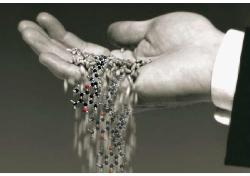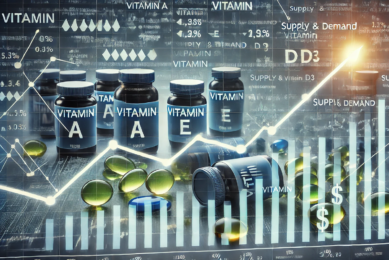Bioavailability of vitamin E stereoisomers

Synthetic vitamin E consists of an equi-molar mixture of eight stereoisomers (RRR -, RRS, RSR, RSS, SRR, SRS, SSR, SSSa – tocopherol stereoisomers) . Not all of these stereoisomers are equally bio-available. Yueming Dersjant-Li and Manfred Peisker explain why this is.
In general, 2R forms (RRR, RRS, RSR, RSS, i.e. R
configuration at position 2 of the side chain) are
bio-available and 2S forms (SSS-, SRS-, SSR-, SRR- i.e. S configuration at
position 2 of the side chain) are basically not bio-available in humans and many
animal species. Recently, a feed grade stable form of natural source vitamin E
became commercially available. Natural vitamin E is derived from vegetable oil
and contains 100% RRR-a-tocopherol stereoisomer. The bio-availability of
different stereoisomers is evaluated by its retention in plasma, milk and target
tissues. Even when the all 8 stereoisomers are supplied in equal amounts in
feed, their retention in plasma, milk and tissues are different. Furthermore,
the bio-availability of these stereoisomers varies among different animal
species.
configuration at position 2 of the side chain) are
bio-available and 2S forms (SSS-, SRS-, SSR-, SRR- i.e. S configuration at
position 2 of the side chain) are basically not bio-available in humans and many
animal species. Recently, a feed grade stable form of natural source vitamin E
became commercially available. Natural vitamin E is derived from vegetable oil
and contains 100% RRR-a-tocopherol stereoisomer. The bio-availability of
different stereoisomers is evaluated by its retention in plasma, milk and target
tissues. Even when the all 8 stereoisomers are supplied in equal amounts in
feed, their retention in plasma, milk and tissues are different. Furthermore,
the bio-availability of these stereoisomers varies among different animal
species.
FIGURE1- RRR-(LEFT), TOTAL 2S-(RIGHT) a-TOCOPHEROL
STEROISOMERS DISTRIBUTION AS PERCENTAGE OF TOTAL A-TOCOPHEROL IN FEED, PLASMA,
MILK (SOWS AND COWS) AND THIGH (BROILERS).
Please see for figure 1 PDF
attachment under article.
STEROISOMERS DISTRIBUTION AS PERCENTAGE OF TOTAL A-TOCOPHEROL IN FEED, PLASMA,
MILK (SOWS AND COWS) AND THIGH (BROILERS).
Please see for figure 1 PDF
attachment under article.
Broilers
Broiler chickens were fed diets supplemented with different
levels of all-rac-a-tocopheryl acetate (syntheticvitamin E) (100, 200 and 400
mg/kg, respectively) and the deposition of a-tocopherol stereoisomer in the
liver and thigh was measured (Cortinas et al
Broiler chickens were fed diets supplemented with different
levels of all-rac-a-tocopheryl acetate (syntheticvitamin E) (100, 200 and 400
mg/kg, respectively) and the deposition of a-tocopherol stereoisomer in the
liver and thigh was measured (Cortinas et al
. 2004). The dietary supplementation
level of all-rac-a-tocopheryl acetate did not affect the stereoisomer retention
profile. When 2R and 2S forms were equally supplied in feed, both tissues
preferentially accumulated 2R stereoisomers.
The 2R/2S ratio determined in this study was 2.3 and 2.2 in
liver and thigh in broilers (Table 1 ).
Sows show higher discrimination of 2R and 2S forms compared
to broilers. Jensen and Lauridsen (2003) measured the a-tocopherol stereoisomer
distribution in feed, the sow’s plasma and its milk. Sows preferentially
retained RRR-a-tocopherol in the plasma and milk. In the feed, RRR-a-tocopherol
stereoisomer represented only 15% of the total a-tocopherol supply. However, in
plasma and milk, more than 30% of the total a-tocopherol was the RRRa-tocopherol
stereoisomer. The feed contained about 50% of the 2S form of stereoisomers. In
the plasma and milk, however, 2S stereoisomers had only less than 10%
bioavailability. The other dietary 2R forms, i.e. RRS. RSR and RSS had a lower
bio-availability compared to the RRR-a-tocopherol stereoisomers (Table
1
).
Piglets are similar to sows. Lauridsen and Jensen (2005) have observed that
when all-rac-a-tocopheryl acetate is supplemented in feed (i.e. when 12.5% RRR
and 50% of 2S form are supplemented in the feed) RRR-a-tocopherol was the
dominating stereoisomer (more than 30% of the total a-tocopherol) retained in
alveolar macrophages, while 2S stereoisomers were not bio-available. The other
dietary 2R forms had a lower bio-availability than the RRR-form. The
a-tocopherol stereoisomer retention in alveolar macrophages was measured as 33,
26, 23, 18 and 0.5% for RRR-, RRS-, RSR-, RSS- and 2S-a-tocopherol stereoisomer
respectively, in piglets at 42 days of age.
when all-rac-a-tocopheryl acetate is supplemented in feed (i.e. when 12.5% RRR
and 50% of 2S form are supplemented in the feed) RRR-a-tocopherol was the
dominating stereoisomer (more than 30% of the total a-tocopherol) retained in
alveolar macrophages, while 2S stereoisomers were not bio-available. The other
dietary 2R forms had a lower bio-availability than the RRR-form. The
a-tocopherol stereoisomer retention in alveolar macrophages was measured as 33,
26, 23, 18 and 0.5% for RRR-, RRS-, RSR-, RSS- and 2S-a-tocopherol stereoisomer
respectively, in piglets at 42 days of age.
Cows
Cows
show an absolute preference for RRR-a-tocopherol. Jensen and Lauridsen (2003)
measured the a-tocopherol stereoisomer distribution in feed, the cow’s plasma
and its milk. The feed contained about 45% of 2S stereoisomers and 32% of the
RRR-a-tocopherol stereoisomer. However, more than 85% and 95% of the total
a-tocopherol was the RRR-a-tocopherol stereoisomer in the milk and in the plasma
respectively (Table 1). This study indicates that dairy cattle strongly
distinguish between different steroisomers with the RRR-a-tocopherol
stereoisomer being the preferred form. Other 2R stereoisomers had very low
bio-availability and 2S stereoisomers were less than 1% bio-available. The
a-tocopherol stereoisomer distribution as a percentage of the total a-tocopherol
in feed, plasma, milk and tissues is illustrated in Figure 1. Clearly,
the RRR-a-tocopherol is primarily retained in the body. The total 2R forms have
much higher percentages of retention than total 2S forms. Even when the 2S forms
contribute almost 50% of the total a-tocopherol in feed, their retention in the
body is very low. Similar results were observed in another study with dairy cows
(Slots et al., 2007), where all-rac-a-tocopheryl acetate was supplemented in the
feed, the natural form (i.e.RRR-a-tocopherol) was the absolutely preferred form
retained in the milk. Other 2R forms had much lower bio-availability compared to
the RRR form. Although the 2S form contributed 35-40% of the total a-tocopherol
intake, the 2S form was not detectable in the milk (Table 2
).
Cows
show an absolute preference for RRR-a-tocopherol. Jensen and Lauridsen (2003)
measured the a-tocopherol stereoisomer distribution in feed, the cow’s plasma
and its milk. The feed contained about 45% of 2S stereoisomers and 32% of the
RRR-a-tocopherol stereoisomer. However, more than 85% and 95% of the total
a-tocopherol was the RRR-a-tocopherol stereoisomer in the milk and in the plasma
respectively (Table 1). This study indicates that dairy cattle strongly
distinguish between different steroisomers with the RRR-a-tocopherol
stereoisomer being the preferred form. Other 2R stereoisomers had very low
bio-availability and 2S stereoisomers were less than 1% bio-available. The
a-tocopherol stereoisomer distribution as a percentage of the total a-tocopherol
in feed, plasma, milk and tissues is illustrated in Figure 1. Clearly,
the RRR-a-tocopherol is primarily retained in the body. The total 2R forms have
much higher percentages of retention than total 2S forms. Even when the 2S forms
contribute almost 50% of the total a-tocopherol in feed, their retention in the
body is very low. Similar results were observed in another study with dairy cows
(Slots et al., 2007), where all-rac-a-tocopheryl acetate was supplemented in the
feed, the natural form (i.e.RRR-a-tocopherol) was the absolutely preferred form
retained in the milk. Other 2R forms had much lower bio-availability compared to
the RRR form. Although the 2S form contributed 35-40% of the total a-tocopherol
intake, the 2S form was not detectable in the milk (Table 2
).
What does this mean?
The Revised Dietary Reference Intakes of vitamin E
published in 2000 by the Food and Nutrition Board (FNB) of the Institute of
Medicine at the U.S. National Academy of Sciences stated that, in humans, the
body can only fully retain the 2R forms of a-tocopherol.
However, 2S-stereoisomers of all-rac-a-tocopherol are not
maintained in human plasma or in tissues. Natural source vitamin E consists of
100% RRR-a-tocopherol. Of the 8 steroisomers that make up the synthetic vitamin
E, only 4 of them (i.e. 50%) are 2R forms. It is therefore defined that all
rac-a-tocopherol has only one-half of the activity of RRR-a-tocopherol in
humans. It was suggested that part of the synthetic racemic a-tocopherol is
identified as foreign and thus degraded, whereas natural source RRR-a-tocopherol
is retained in the body (Brigelius-Flohé et al
The Revised Dietary Reference Intakes of vitamin E
published in 2000 by the Food and Nutrition Board (FNB) of the Institute of
Medicine at the U.S. National Academy of Sciences stated that, in humans, the
body can only fully retain the 2R forms of a-tocopherol.
However, 2S-stereoisomers of all-rac-a-tocopherol are not
maintained in human plasma or in tissues. Natural source vitamin E consists of
100% RRR-a-tocopherol. Of the 8 steroisomers that make up the synthetic vitamin
E, only 4 of them (i.e. 50%) are 2R forms. It is therefore defined that all
rac-a-tocopherol has only one-half of the activity of RRR-a-tocopherol in
humans. It was suggested that part of the synthetic racemic a-tocopherol is
identified as foreign and thus degraded, whereas natural source RRR-a-tocopherol
is retained in the body (Brigelius-Flohé et al
., 2002). The degradation of all-rac-a-tocopherol is 3-4 times higher than
that of RRR-a-tocopherol.
The above-mentioned studies confirm that in animals,
when a commonly used synthetic vitamin E (i.e. allrac-a-tocopherol) is
supplemented in the feed, not all of the 8 stereoisomers are equally
bio-available. The bio-availability of the different stereoisomers is related to
different animal species. RRR-a-tocopherol is by far the most bio-available
stereoisomer for cows and pigs. Other 2R stereoisomers (RRS, RSR, RSS) have
lower bioavailability than RRR-a-tocopherol stereoisomer. In broilers, the 2R
forms have a higher bio-availability than 2S forms. In general, 2S stereoisomers
are essentially not bioavailable, even when they contribute 50% of the total a-tocopherol in feed
(except for broilers). The extent of utilisation of stereoisomers other than the
RRR-a-stereoisomer depends on the species. The rank of distinction of
stereoisomers between these species is: cows>swine>poultry. Within a
species, the utilisation of different a-tocopherol stereoisomers may depend on
the animal’s metabolic status and tissues studied.
when a commonly used synthetic vitamin E (i.e. allrac-a-tocopherol) is
supplemented in the feed, not all of the 8 stereoisomers are equally
bio-available. The bio-availability of the different stereoisomers is related to
different animal species. RRR-a-tocopherol is by far the most bio-available
stereoisomer for cows and pigs. Other 2R stereoisomers (RRS, RSR, RSS) have
lower bioavailability than RRR-a-tocopherol stereoisomer. In broilers, the 2R
forms have a higher bio-availability than 2S forms. In general, 2S stereoisomers
are essentially not bioavailable, even when they contribute 50% of the total a-tocopherol in feed
(except for broilers). The extent of utilisation of stereoisomers other than the
RRR-a-stereoisomer depends on the species. The rank of distinction of
stereoisomers between these species is: cows>swine>poultry. Within a
species, the utilisation of different a-tocopherol stereoisomers may depend on
the animal’s metabolic status and tissues studied.
Conclusion
RRR-a-tocopherol is preferentially transferred from feed to
plasma, milk and tissues. Natural source vitamin E, that is, vitamin E produced
from vegetable oils, containing 100% RRR-a-tocopherol stereoismer in the stable
form as RRR-a-tocopheryl acetate, has a much higher bio-availability than
synthetic vitamin E in animals. <-
RRR-a-tocopherol is preferentially transferred from feed to
plasma, milk and tissues. Natural source vitamin E, that is, vitamin E produced
from vegetable oils, containing 100% RRR-a-tocopherol stereoismer in the stable
form as RRR-a-tocopheryl acetate, has a much higher bio-availability than
synthetic vitamin E in animals. <-
Source: Feed Mix vol 15 nr 5











